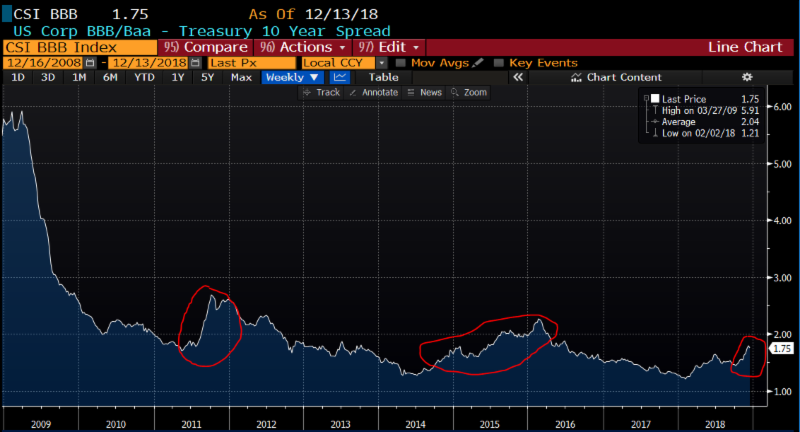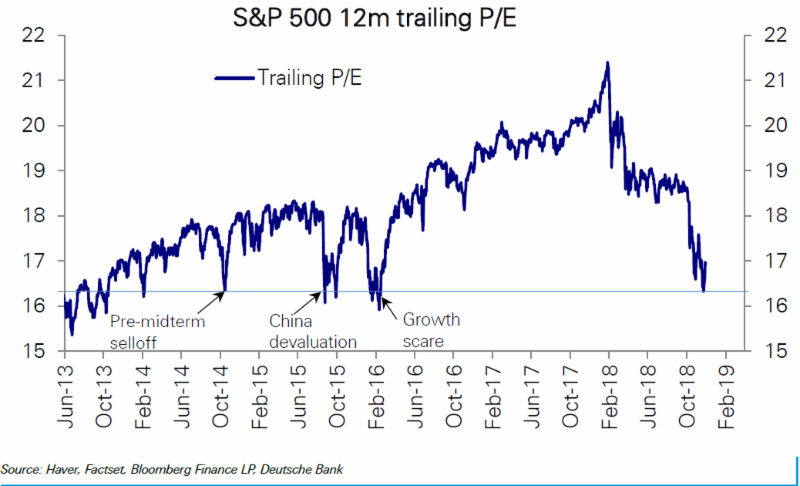17 May December 2018 – Is the Third Time a Charm?
Volatility is back! After an abnormally calm 2017 in the financial markets, volatility returned this year. With about 2 weeks left in the year, the S&P 500 has gone through one 10% pullback and five additional 6% – 8% pullbacks during 2018, with a peak to trough pullback of about 13%. At the time of this writing, both the U.S. stock and bond markets are down slightly on the year, and international equity markets are down more than 10%. Few investments have “worked” in 2018, and cash has been one of the best performing asset classes.
The current economic expansion in the United States is the second longest on record, poised to become the longest on record next summer. The simple length of this cycle makes it almost certain that we are closer to the end than the beginning. Because of this late-cycle timing, investors are constantly searching for clues as to when the next recession will be upon us. Interestingly, during the current expansion, we have gone through two intra-cycle “resets” in which fears of the next recession intensified. In both cases, volatility increased and equity market returns were subdued. Once the fears passed and economic growth continued, the stock market reacted positively.
One signal of an upcoming economic downturn can be seen in credit spreads. A credit spread is the increased interest rate of a bond issued by a company over a corresponding US Treasury bond. Investors demand this extra interest in order to compensate for increased risk of default. If investors are concerned about near-term economic conditions, credit spreads will widen as defaults are expected to increase. If investors are positive about near-term economic conditions, credit spreads will narrow because investors are confident they will be paid back. Below is a 10 year cha rt of BBB credit spreads. BBB is the lowest rating of investment grade (high quality) bonds.

As you can see, credit spreads narrowed significantly in 2009 after the passing of the financial crisis. These spreads widened twice during the current economic expansion: in late 2011 and in late 2014 through early 2016, the two intra-cycle “resets” mentioned earlier. As spreads have started to widen again over the last two months, we revisited the two previous episodes for clues on the current environment.
2011 was marked by fears of Greece leaving the European Union, the related European debt crisis, and the S&P downgrade of US debt. Talk of a double dip recession was common, and volatility in the equity markets increased.
Late 2014 through early 2016 saw oil prices collapse, decreasing over 50%. China devalued its currency, investors had serious concerns about the growth outlook, and volatility again increased.
The current spike in volatility has commonalities with both previous intra-cycle resets. Oil is down over 30%. Macro concerns dominate the news wires with trade relations between the US and China at the forefront. Also, each episode included consternation of the Federal Reserve’s next move.
The main difference between the two earlier periods and now is the lack of support from global central banks. In 2011, central banks were still undergoing an asset purchasing program known as quantitative easing to support financial markets as they recovered from the financial crisis. In 2015, the Fed had not begun raising rates, and other global central banks continued to pursue quantitative easing. Today the Fed is raising rates and quantitative easing has ended.
In each of the previous bouts of volatility, the macro clouds cleared, growth resumed, and the equity markets reacted positively. Are we set to repeat this pattern again or are we finally headed for the next recession? The outcome is far from guaranteed, but at this point it appears we are more likely than not to find a resolution to the current growth scare in a similar manner to the last two. Economic data remains solid, highlighted by employment growth, wage growth, and consumer spending. Admittedly, trade negotiations between the US and China are difficult to predict, but I do believe it is in both sides’ best interests to find common ground. Both administrations want to avoid a recession and both are keenly aware of movements in the financial markets. In addition, the Fed has hinted strongly that the pace of interest rate increases is set to slow.
Pullbacks in the equity markets naturally make stocks less expensive, and can create opportunities. As you can see below, stock valuations (as measured by trailing price to earnings multiples) have become much more reasonable and returned to the level last seen during the bout of volatility in 2015 and early 2016.

Since bottoming in March 2009, the S&P 500 has returned 368%, which is equivalent to about 17% per year. During this period we have experienced roughly twenty-five pullbacks of at least 5%. About 3/4 of these pullbacks were between 5% and 10%, with the other 1/4 between 10% and 20%. Each pullback created anxiety for some investors, reinforced by negative news commentary about a litany of things to worry about. The next recession always seemed to be near. Eventually one of these doomsday articles will be right and the next recession and bear market will be upon us, but over the last nine years these warnings have been continuously wrong.
Unfortunately a binary, black and white outcome is not known until after the fact. In the moment, investors must deal with probabilities. Could the US and China escalate into a trade war? Could the Fed raise rates too far? Could a long list of other potential problems manifest into a bear market? The answer is absolutely! These are not zero probability events. In order to navigate the markets for our clients, we position investment portfolios towards what we believe is the most likely outcome, while giving proper balance and respect to the many risks in front of us.
Tom Searson, CFA
